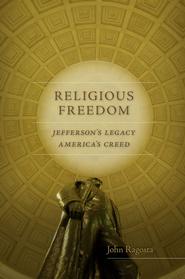
WAMC/Northeast Public Radio’s Academic Minute will feature Visiting Assistant Professor of History John Ragosta's essay on National Day of Prayer, on Thursday, May 2. Ragosta, author of the newly published Religious Freedom: Jefferson's Legacy, America's Creed, provides a brief summary of the role of prayer in U.S. history.
May 2 has been the National Day of Prayer since 1952, but, according to Ragosta, Americans have been called to days of prayer since the American Revolution. Ragosta explains that, “Thomas Jefferson refused to make official proclamations about prayer, insisting that they violated the First Amendment. He wrote: ‘Every religious society has a right to determine for itself the times for these [religious] exercises, … and this right can never be safer than in their own hands, where the constitution has deposited it.’” Ragosta suggests that on May 2, “… people of all denominations might well recall Jefferson’s private words of prayer during his first inaugural address: ‘lead our councils to what is best, and give them a favorable issue for [our] peace and prosperity.’”
According to the WAMC’s website, “The Academic Minute features a different professor each day, drawing experts from top research institutions.” The broadcast can be heard locally at 7:34 a.m. or 3:56 p.m. at 90.3 FM and at InsideHigherEd.com.
Religious Freedom: Jefferson's Legacy, America's Creed was released by the University of Virginia Press in March. According to the publisher, Ragosta “offers a vigorous defense of Jefferson’s advocacy for a strict separation of church and state. Beginning with a close look at Jefferson’s own religious evolution, Ragosta shows that deep religious beliefs were at the heart of Jefferson’s views on religious freedom. Basing his analysis on that Jeffersonian vision, Ragosta redefines our understanding of how and why the First Amendment was adopted. He shows how the amendment’s focus on maintaining the authority of states to regulate religious freedom demonstrates that a very strict restriction on federal action was intended. Ultimately revealing that the great sage demanded a firm separation of church and state but never sought a wholly secular public square, Ragosta provides a new perspective on Jefferson, the First Amendment, and religious liberty within the United States.”
This book establishes a number of critical points:
- Thomas Jefferson was emphatically not a Christian. He was a committed theist who thought Jesus a great philosopher, but he rejected any notion of Jesus’ divinity (calling his beliefs “Christianism”). It was Jefferson’s deeply-felt religious beliefs that demanded he support broad religious freedom, including a separation between church and state.
- Devout evangelicals (especially Presbyterians and Baptists) provided essential political sup¬port to Jefferson and James Madison as they fought for religious freedom and passage of the Virginia Statute for Establishing Religious Freedom. For theological and political reasons, evangelicals joined in denouncing any mixture of church and state.
- The First Amendment imposed a Jeffersonian prohibition on government religious estab-lishments. Contrary to the conventional wisdom that the First Amendment was a vague compromise, or the modern conservative view that it simply left religion to the states, the only position that could achieve the necessary support in Congress was the strict protection for religious freedom championed by James Madison and his mentor, Jefferson.
- Throughout the early 19th century, Jefferson’s vision came to define Americans’ understand¬ing of the meaning of religious freedom. State-after-state adopted strict protections for religious freedom and separation of church and state based on a Jeffersonian vision.
- In 1879, in Reynolds v. United States, the Supreme Court unanimously declared that the religious freedom protected by the First Amendment was best understood in Jeffersonian terms. This view was almost unanimous on the Court until 1978 when conservative re¬visionists, led by Justice William Rehnquist, sought to minimize Jefferson’s role.
- Still, while insisting on broad protections for religious freedom and a wall of separation between church and state, Jefferson did not seek to purge the public square of religion. He prayed for divine blessings in his own inaugural addresses. What he emphatically rejected was any government role in religion. Freedom – educational, political, and religious freedom – demanded that each person decide religious questions for him or herself without government involvement.
